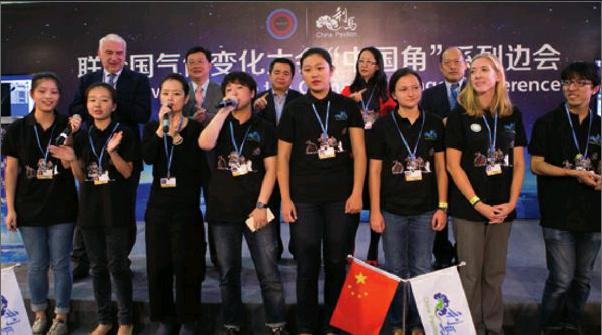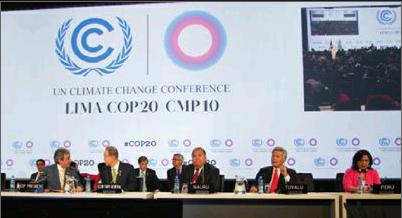An Arduous Tug of War
2015-01-15ByDengYaqing
By+Deng+Yaqing


After a 32-hour delay, the annual UN climate talks finally came to a close in Lima, Peru, when Peruvian Environment Minister Manuel PulgarVidal struck the gavel in the wee hours of December 14. Formally known as the COP20, or the 20th Session of the Conference of the Parties to the UN Framework Convention on Climate Change (UNFCCC), the two-weeklong negotiations involved negotiators from more than 190 countries and organizations. Its conclusion marks a step forward to a new agreement addressing climate change, which is tentatively scheduled to be passed at the end of 2015 in Paris and go into effect in 2020.
“Humans clearly influence the climate system, and recent anthropogenic emissions of greenhouse gases are the highest in history,” the Intergovernmental Panel on Climate Change said in an assessment report released on November 2.
The agreement reached by climate negotiators in Lima put forward a wide range of options for a global pact to be reached in Paris, which will aim to prevent the global average temperature from rising more than 2 degrees Celsius above preindustrial levels. Each participating nation is directed to submit its own plans for curbing global warming in the first half of 2015.
“Developing countries have shown their utmost sincerity and left no stones unturned in achieving positive and balanced results at the conference. However, limited progress has been made by developed countries in realizing the emissions targets laid out in the Kyoto Protocol Amendment,” said Xie Zhenhua, head of the Chinese delegation and Vice Minister of the National Development and Reform Commission (NDRC), noting that negotiations at the Paris conference would be arduous and should be carried out in a determined, ambi- tious and flexible manner.
“The result is not perfect, but in the interests of all parties, making sure that all the people will do more to cope with climate change,” said Brazils chief negotiator JoséAntonio Marcondes de Carvalho, who expected a more ambitious result.
EU Climate Action and Energy Commissioner Miguel Arias Canete believes the new draft in Lima has laid a solid foundation for reaching an agreement in Paris next year by determining the elements that should be included in it.
Divisions and contradictions
“Postponement is almost a rule of climate change negotiations,” Xie said before the convening of the Lima conference. This time, longstanding divisions between developed and developing countries again kept them from reaching an agreement at the set time.endprint
The principle of common but differentiated responsibilities—the “red line” for many developing countries—was not reflected in the preliminary draft of the Lima deal, so it was not approved by all parties. With Manuel Pulgar-Vidal coordinating and meditating the interests of all the countries, negotiators decided to include the principle of common but differentiated responsibilities into the agreement by quoting the related statement in a China-U.S. joint announcement on climate change that was released on November 12. China and the United States“are committed to reaching an ambitious 2015 agreement that reflects the principle of common but differentiated responsibilities and respective capabilities, in light of different national circumstances,” according to the joint document. Moreover, other elements of major concerns were brought back to the table, such as the loss and damage mechanism advocated by the Alliance of Small Island States.
“The conference achieved an acceptable but not satisfying result,” Xie said, admitting that the agreement was in line with Chinas expectations but also left unresolved issues to the Paris conference.
One point of contention is that rich countries insist the pledges should focus on efforts to control greenhouse gas emissions, and try to force emerging economies such as China and India into the emissions reduction system.
Nicholas Stern, Chair of the Londonbased Grantham Research Institute on Climate Change and the Environment, ar- gued that developed countries should take greater responsibility for problems arising from climate change, as they now possess more wealth and emitted more greenhouse gases in the past than developing countries.
As developed countries have gradually moved many industries to the developing world by virtue of their advantageous position in terms of global economy, politics and power, carbon emissions have also been transferred to these emerging economies.“The developed world is historically accountable for global warming,” said Zou Ji, Deputy Director of Chinas National Center for Climate Change Strategy and International Cooperation.
Beyond that, developed and developing countries should take distinctive responsibilities because they are at different developmental stages. While carbon emissions in developed countries mainly come from consumption, construction and transportation, productive consumption is the primary emission source in developing countries. “The developed world has finished industrialization, while the developing world is still in the middle of it,” Zou said.endprint
“The gap between developed and developing countries is still considerably wide. Economic growth, social development and poverty reduction remain the primary tasks of developing nations,” Xie said, suggesting that developed countries should act on the principles and regulations of the UNFCCC and continue to take the lead in reducing emissions while providing necessary capital, technology and capacity building support to developing countries.
However, developed countries have resisted calls for more robust financial support. According to the UNFCCC, developed countries should fulfill the obligations of providing sufficient funding to developing countries to cope with climate change. The funding negotiations, including those for technology transfer, however, have made little progress over the past two decades.
In December 2013, the UN launched the Green Climate Fund, which aims at helping developing countries tackle climate change, in Seoul, the Republic of Koreas capital. The pledges to the program amounted to a mere $10.2 billion at the Lima conference, far less than the 2020 target of $100 billion. Moreover, there is no clear roadmap for how to achieve the ambitious goal.
“Developed countries should honor their commitments and shoulder their responsibilities under the UNFCCC to offer more supports to developing countries in terms of mitigation, finance, technology and capability building,” Xie said.
Chinas efforts
According to the China-U.S. joint announcement on climate change, the United States has set a target of reducing its emissions by 26 to 28 percent below its 2005 level in 2025, while China has pledged to achieve a peak of carbon dioxide emissions around 2030 and increase the share of non-fossil fuels in primary energy consumption to around 20 percent by 2030.
UN Secretary General Ban Ki-moon said that the China-U.S. joint announcement will exert a significant influence on negotiations and actions concerning climate change and create a useful model for solving problems regarding the principle of common but differentiated responsibilities.
Executive Secretary of the UNFCCC Christiana Figueres also believes the commitments of China and the United States are a significant political impetus to the Lima conference. The China-U.S. Joint Announcement alone cannot solve the climate change problem, but without it, solving the problem will be completely impossible, Figueres said.endprint
According to statistics from Chinas Policies and Actions on Climate Change(2014) report released on November 25, as of 2013, Chinas carbon dioxide emissions per unit of per-capita GDP had been reduced by 28.56 percent from 2005; and in the first three quarters this year, Chinas energy consumption intensity and carbon intensity further dropped by 4.6 percent and 5 percent year on year, respectively. In 2013, a total of 6.1 million hectares of forest and 2.52 billion trees were planted, surpassing the target for the year.
According to World Bank estimates, from 1990 to 2010, Chinas energy-conserving efforts accounted for 58 percent of the worlds total energy efficiency. Moreover, the countrys installed capacity of renewable energy has accounted for 24 percent of the worlds total, and its newly installed renewable energy capacity made up 37 percent of the global total in 2013, according to the NDRC.
From 2011 to 2013, China provided an annual financial support of $10 million for developing countries to enhance their capacity to deal with climate change. At the UN Climate Summit held in September, Vice Premier Zhang Gaoli, special envoy of Chinese President Xi Jinping, announced that China would double its assistance and establish the South-South Cooperation Fund in 2015.
Since 2011, China has invested a total of 270 million yuan ($43.99 million) in assisting developing countries efforts to address climate change and trained nearly 2,000 climate change officials and professionals from developing countries, according to statistics from the NDRC.
Xie noted that China will not jockey for the financial assistance provided by the Green Climate Fund with its “poor brothers,”and will instead help them to receive more money from the fund through South-South cooperation.
Executive Director of the UN Environment Programme Achim Steiner said that the establishment of the South-South Cooperation Fund will invigorate cooperation between developing countries on tackling climate change.
Developing countries need to carry out pragmatic cooperation, as well as technological and knowledge sharing so that correct decisions can be made in dealing with climate change. However, in this aspect, what has been done for them by developed countries is far from sufficient, said Egyptian Minster of Environment Khaled Mohamed Fahmy Abdel Aal.
“China has not only made its contribution to the fight against climate changes, but also helped many less developed countries through South-South cooperation,”he added.endprint
